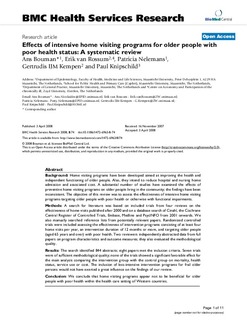| dc.contributor.author | Bouman, A. | |
| dc.contributor.author | van Rossum, E. | |
| dc.contributor.author | Nelemans, P. | |
| dc.contributor.author | Kempen, G.I.J.M. | |
| dc.contributor.author | Knipschild, P. | |
| dc.date.accessioned | 2018-01-16T10:50:16Z | |
| dc.date.available | 2018-01-16T10:50:16Z | |
| dc.date.issued | 2008 | |
| dc.identifier.citation | Bouman, A., van Rossum, E., Nelemans, P., Kempen, G.I.J.M. & Knipschild, P. (2008) Effects of intensive home visiting programs for older people with poor health status: A systematic review. (Research article). BMC Health Services Research, 8(74), 74. | nb_NO |
| dc.identifier.uri | http://hdl.handle.net/11250/2477747 | |
| dc.description.abstract | Background: Home visiting programs have been developed aimed at improving the health and independent functioning of older people. Also, they intend to reduce hospital and nursing home admission and associated cost. A substantial number of studies have examined the effects of preventive home visiting programs on older people living in the community; the findings have been inconsistent. The objective of this review was to assess the effectiveness of intensive home visiting programs targeting older people with poor health or otherwise with functional impairments.
Methods: A search for literature was based on included trials from four reviews on the effectiveness of home visits published after 2000 and on a database search of Cinahl, the Cochrane Central Register of Controlled Trials, Embase, Medline and PsycINFO from 2001 onwards. We also manually searched reference lists from potentially relevant papers. Randomized controlled trials were included assessing the effectiveness of intervention programsconsisting of at least four home visits per year, an intervention duration of 12 months or more, and targeting older people (aged 65 years and over) with poor health. Two reviewers independently abstracted data from full papers on program characteristics and outcome measures; they also evaluated the methodological quality.
Results: The search identified 844 abstracts; eight papers met the inclusion criteria. Seven trials were of sufficient methodological quality; none of the trials showed a significant favorable effect for the main analysis comparing the intervention group with the control group on mortality, health status, service use or cost. The inclusion of less-intensive intervention programs for frail older persons would not have exerted a great influence on the findings of our review.
Conclusion: We conclude that home visiting programs appear not to be beneficial for older people with poor health within the health care setting of Western countries. | nb_NO |
| dc.publisher | BMC Health Services Research | nb_NO |
| dc.rights | Navngivelse 4.0 Internasjonal | * |
| dc.rights.uri | http://creativecommons.org/licenses/by/4.0/deed.no | * |
| dc.subject | home visiting programmes | nb_NO |
| dc.subject | independent functioning | nb_NO |
| dc.subject | associated cost | nb_NO |
| dc.title | Effects of intensive home visiting programs for older people with poor health status: A systematic review | nb_NO |
| dc.type | Journal article | nb_NO |
| dc.source.pagenumber | 74 | nb_NO |
| dc.source.volume | 8 | nb_NO |
| dc.source.journal | BMC Health Services Research | nb_NO |
| dc.source.issue | 74 | nb_NO |
| dc.identifier.doi | https://doi.org/10.1186/1472-6963-8-74 | |

